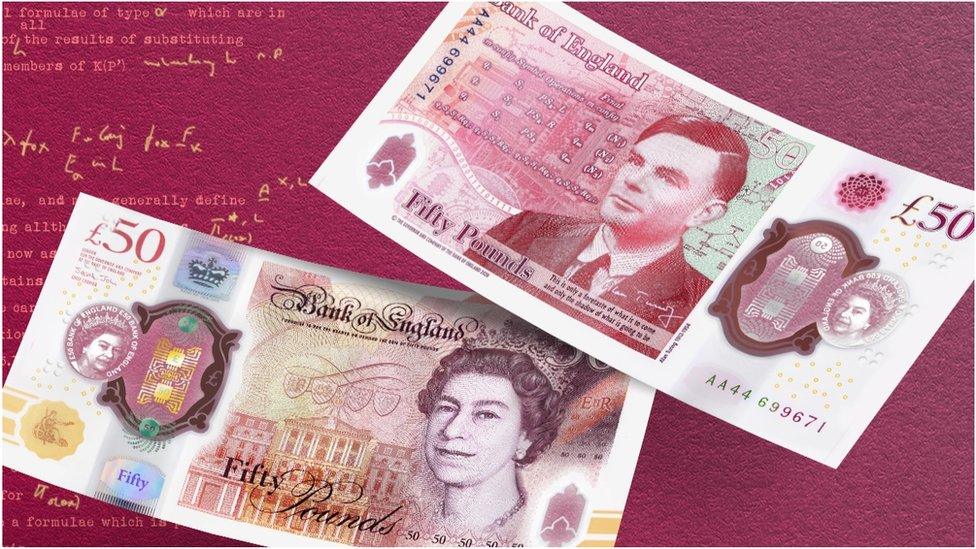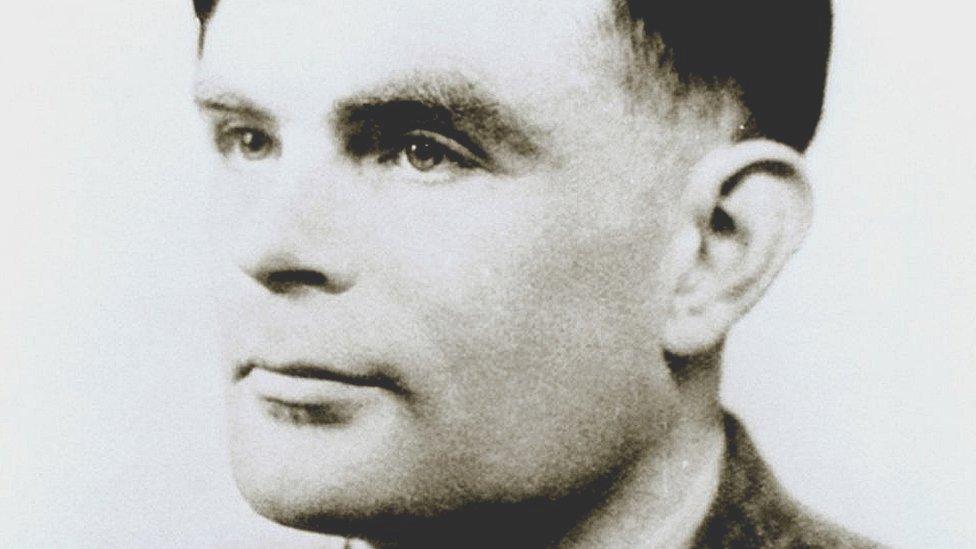New Alan Turing £50 note design is revealed
- Published

The £50 note will be made of polymer for the first time
The design of the Bank of England's new £50 note, featuring the computer pioneer and codebreaker Alan Turing, has been revealed.
The banknote will enter circulation on 23 June, which would have been the mathematician's birthday.
It will be the last of the Bank's collection to switch from paper to polymer. In keeping with Alan Turing's work, the set is its most secure yet.
Old paper £50 notes will still be accepted in shops for some time.
Why is Alan Turing on the note?
The work of Alan Turing, who was educated in Sherborne, Dorset, helped accelerate Allied efforts to read German Naval messages enciphered with the Enigma machine. His work is said to have been key to shortening World War Two and saving lives.
Less celebrated is the pivotal role he played in the development of early computers, first at the National Physical Laboratory and later at the University of Manchester.
1912 – 1954
1912 Alan Mathison Turing was born in West London
1936 Produced “On Computable Numbers”, aged 24
1952 Convicted of gross indecency for his relationship with a man
2013 Received royal pardon for the conviction
In 2013, he was given a posthumous royal pardon for his 1952 conviction for gross indecency. He had been arrested after having an affair with a 19-year-old Manchester man, and was forced to take female hormones as an alternative to prison. He died at the age of 41. An inquest recorded his death as suicide.
Andrew Bailey, the governor of the Bank of England, said: "He was a leading mathematician, developmental biologist, and a pioneer in the field of computer science.
"He was also gay, and was treated appallingly as a result. By placing him on our new polymer £50 banknote, we are celebrating his achievements, and the values he symbolises."
The Bank is flying the rainbow flag above its Threadneedle Street building in London as a result.
However, campaigners are still questioning how much the Bank's collection of banknotes represents society. Three feature men - Winston Churchill on the £5 note, JMW Turner on the £20 note, and soon Alan Turing on the £50 note. Only the £10 note, with the portrait of Jane Austen, depicts a woman apart from the Queen, and all are white.
In an interview with the BBC, Mr Bailey said he wanted to see diverse ethnic minorities represented on future banknotes.
He added that the portrait of Mr Turing on the new £50 note was an important symbol of diversity.
What features are on the note?
Steam engine pioneers James Watt and Matthew Boulton appear on the current £50 note, issued in 2011.
The new note will feature:
A photo of Turing taken in 1951 by Elliott and Fry, and part of the National Portrait Gallery's collection
A table and mathematical formulae from Turing's 1936 paper "On Computable Numbers, with an application to the Entscheidungsproblem" - foundational for computer science
The Automatic Computing Engine (ACE) Pilot Machine - the trial model of Turing's design and one of the first electronic stored-program digital computers
Technical drawings for the British Bombe, the machine specified by Turing and one of the primary tools used to break Enigma-enciphered messages
A quote from Alan Turing, given in an interview to The Times newspaper on 11 June 1949: "This is only a foretaste of what is to come, and only the shadow of what is going to be"
His signature from the visitor's book at Max Newman's House in 1947 which is on display at Bletchley Park
Ticker tape depicting Alan Turing's birth date (23 June 1912) in binary code. The concept of a machine fed by binary tape featured in Turing's 1936 paper

Sarah John, the Bank of England's chief cashier, whose signature is on the note
There are also a series of security features, similar to other notes, including holograms, see-through windows - based partly on images of Bletchley Park - and foil patches.
The Bank also says that plastic banknotes are more durable and harder to forge.
Sarah John, the Bank's chief cashier whose signature features on the note, said: "This new £50 note completes our set of polymer banknotes. These are much harder to counterfeit, and with its security features the new £50 is part of our most secure series of banknotes yet."
Do we need a £50 note?
The £50 note is the least likely to be in people's wallets or purses.
There were 351 million £50 notes in circulation last year, out of a total of nearly four billion Bank of England notes.
The government has previously discussed whether it should be abolished.
The banknote was described by Peter Sands, former chief executive of Standard Chartered bank, as the "currency of corrupt elites, of crime of all sorts and of tax evasion".
The debate continues, with the added element that cash use has declined, particularly during the Covid pandemic.


The UK's intelligence agency GCHQ has set what it describes as its toughest ever puzzle to mark the new note.
Twelve puzzles - called the Turing Challenge - increase in complexity leading to one final answer. The agency's in-house experts claim that 'an experienced puzzler' should be able to complete it in just seven hours.
Few clues are provided other than that each is based on unique design elements of the banknote, including technical drawings for the device designed by Turing during World War Two to break the German Enigma code at Bletchley Park.
Although Turing was, among other accomplishments, the co-creator of the first computer chess programme he claimed not to be that good at puzzles himself.
The new note though marks another step in the recognition of a man whose wartime work was secret, and who took his own life soon after his conviction for homosexuality in 1952.
"Turing was embraced for his brilliance and persecuted for being gay," said current GCHQ Director Fleming. "His legacy is a reminder of the value of embracing all aspects of diversity, but also the work we still need to do to become truly inclusive."

Related topics
- Published17 March 2021

- Published3 March 2021

- Published16 July 2019

- Published15 February 2021

- Published9 November 2020

- Published20 June 2012
